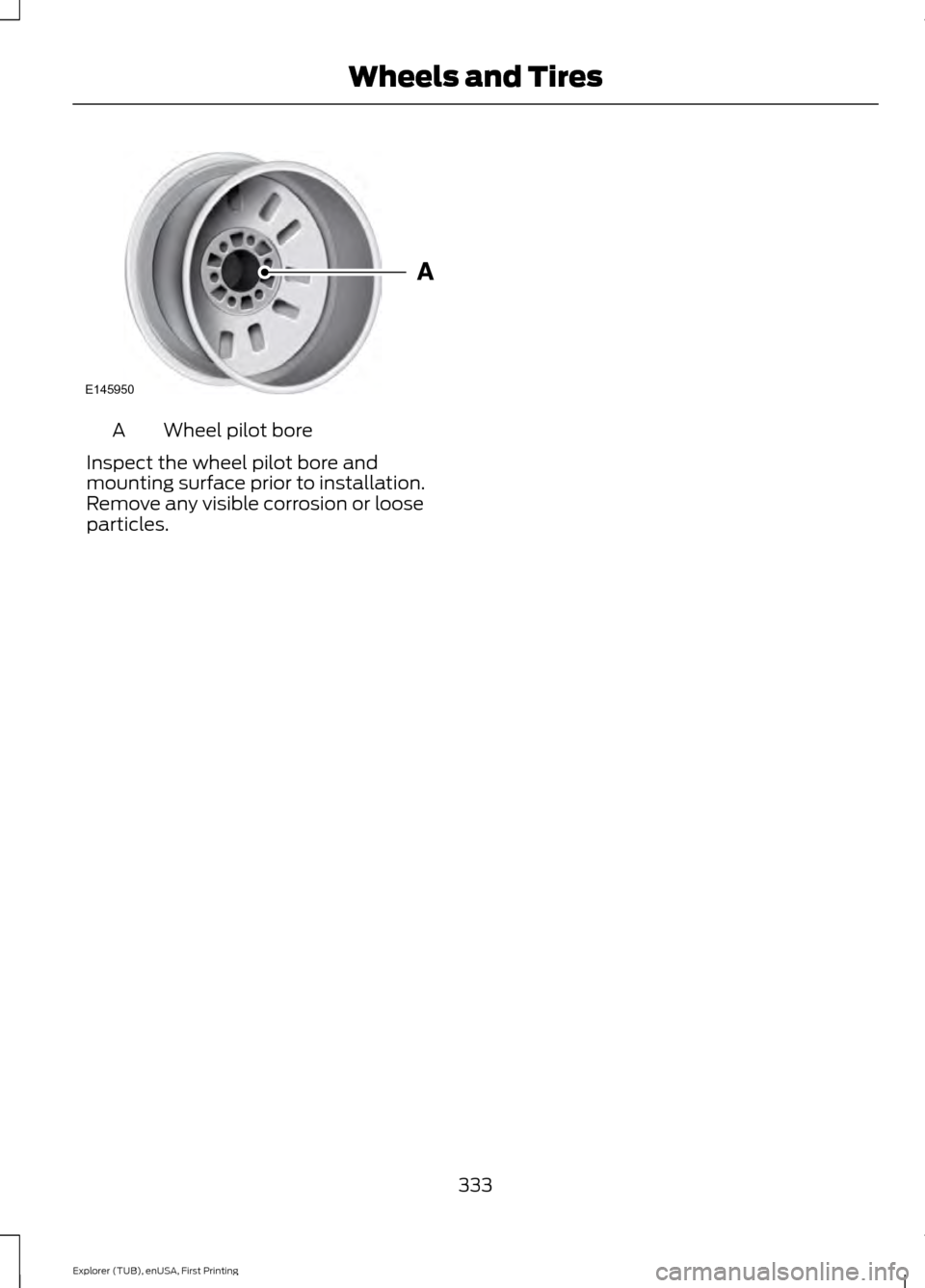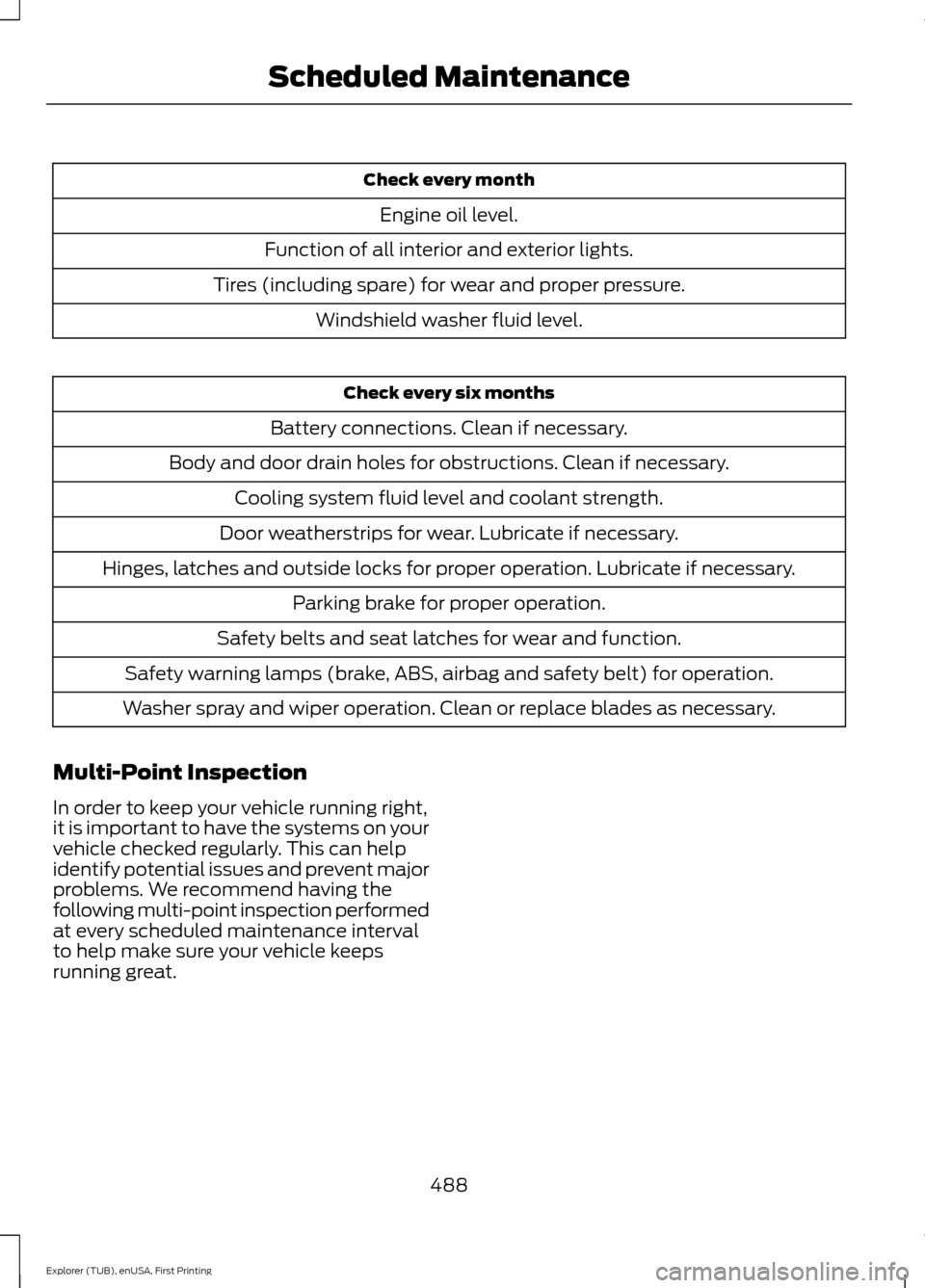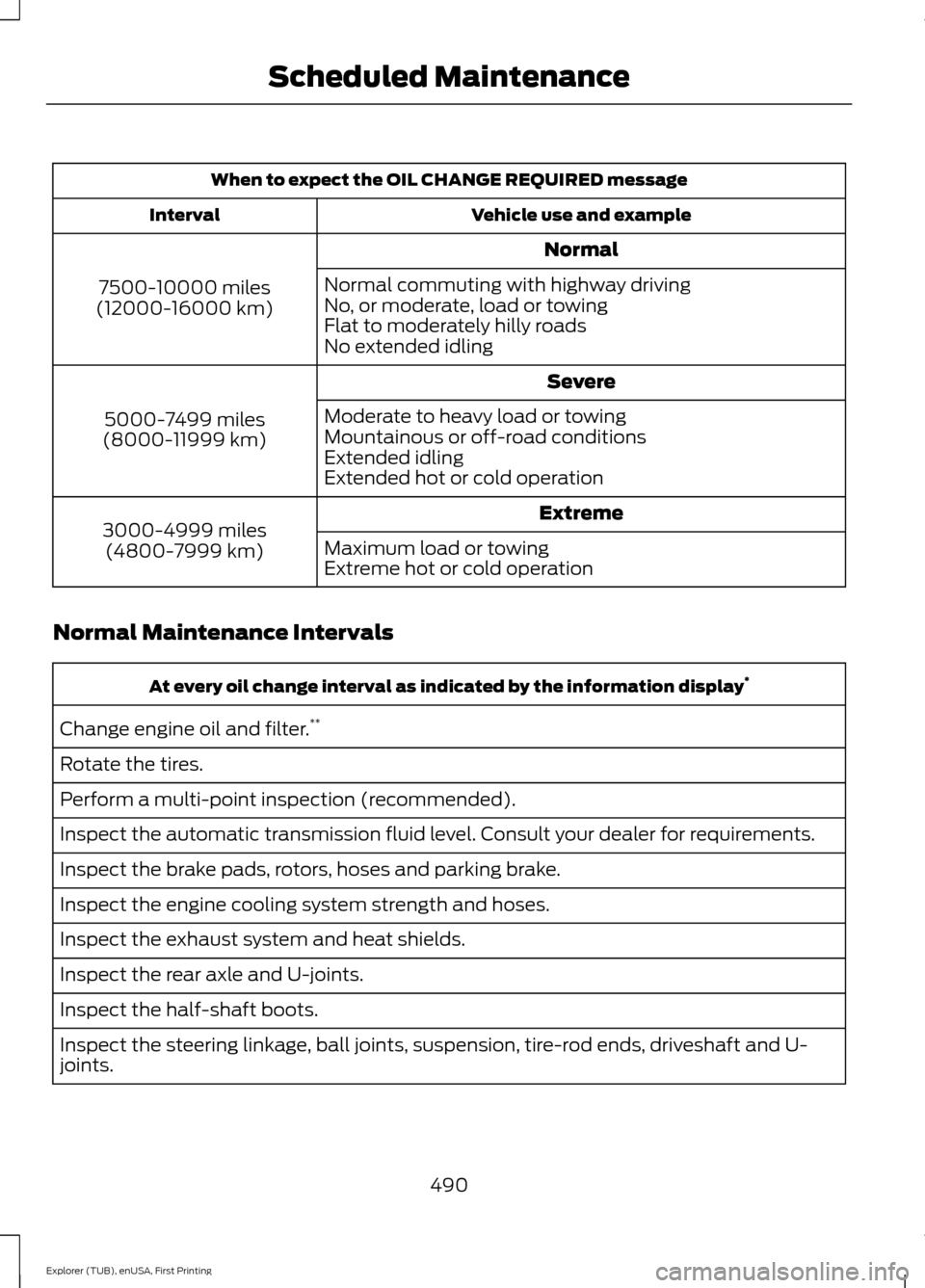2016 FORD EXPLORER tires
[x] Cancel search: tiresPage 335 of 541

2. Fasten the flat tire to the luggage
compartment back panel by inserting
the L-shaped bolt through one of the
lug bolt holes in the wheel.
3. Turn the L-shaped bolt clockwise into the threaded hole in the luggage
compartment back panel until the tire
is secured. 4.
Unblock the diagonally opposite wheel.
Stowing the jack With the road wheel in the vertical position
in the spare tire tub, the jack assembly will
not fit in its standard position. Secure the
jack in the alternate position by inserting
the wing bolt through the jack as shown.
TECHNICAL SPECIFICATIONS
Wheel Lug Nut Torque Specifications WARNING
When a wheel is installed, always remove any corrosion, dirt or foreign materials
present on the mounting surfaces of the wheel or the surface of the wheel hub,
brake drum or brake disc that contacts the wheel. Make sure that any fasteners
that attach the rotor to the hub are secured so they do not interfere with the mounting
surfaces of the wheel. Installing wheels without correct metal-to-metal contact at the
wheel mounting surfaces can cause the wheel nuts to loosen and the wheel to come off
while your vehicle is in motion, resulting in loss of control. Ib-ft (Nm)
*
Bolt size
100 (135)
1/2-20 x 1.5
* Torque specifications are for nut and bolt threads free of dirt and rust. Use only Ford
recommended replacement fasteners.
Retighten the lug nuts to the specified torque within 100 miles (160 kilometers) after any
wheel disturbance (such as tire rotation, changing a flat tire, wheel removal).
332
Explorer (TUB), enUSA, First Printing Wheels and TiresE194296 E194297
Page 336 of 541

Wheel pilot bore
A
Inspect the wheel pilot bore and
mounting surface prior to installation.
Remove any visible corrosion or loose
particles.
333
Explorer (TUB), enUSA, First Printing Wheels and TiresE145950
Page 491 of 541

Check every month
Engine oil level.
Function of all interior and exterior lights.
Tires (including spare) for wear and proper pressure. Windshield washer fluid level. Check every six months
Battery connections. Clean if necessary.
Body and door drain holes for obstructions. Clean if necessary. Cooling system fluid level and coolant strength.
Door weatherstrips for wear. Lubricate if necessary.
Hinges, latches and outside locks for proper operation. Lubricate if necessary. Parking brake for proper operation.
Safety belts and seat latches for wear and function.
Safety warning lamps (brake, ABS, airbag and safety belt) for operation.
Washer spray and wiper operation. Clean or replace blades as necessary.
Multi-Point Inspection
In order to keep your vehicle running right,
it is important to have the systems on your
vehicle checked regularly. This can help
identify potential issues and prevent major
problems. We recommend having the
following multi-point inspection performed
at every scheduled maintenance interval
to help make sure your vehicle keeps
running great.
488
Explorer (TUB), enUSA, First Printing Scheduled Maintenance
Page 492 of 541

Multi-Point inspection
Hazard warning system operation
Accessory drive belt(s)
Horn operation
Battery performance
Radiator, cooler, heater and air conditioninghoses
Engine air filter
Suspension components for leaks ordamage
Exhaust system
Steering and linkage
Exterior lamps operation
Tires (including spare) for wear and properpressure**
Fluid levels *
; fill if necessary
Windshield for cracks, chips or pits
For oil and fluid leaks
Washer spray and wiper operation
Half-shaft dust boots
* Brake, coolant recovery reservoir, automatic transmission and window washer
** If your vehicle is equipped with a temporary mobility kit, check the tire sealant expiration
Use By date on the canister. Replace as needed.
Be sure to ask your dealership service
advisor or technician about the multi-point
vehicle inspection. It is a comprehensive
way to perform a thorough inspection of
your vehicle. Your checklist gives you
immediate feedback on the overall
condition of your vehicle.
NORMAL SCHEDULED
MAINTENANCE
Intelligent Oil-Life Monitor™
Your vehicle is equipped with an Intelligent
Oil-Life Monitor that determines when you
should change the engine oil based on how
your vehicle is used. By using several
important factors in its calculations, the
monitor helps reduce the cost of owning
your vehicle and reduces environmental
waste at the same time. This means you do not have to remember
to change the oil on a mileage-based
schedule. Your vehicle lets you know when
an oil change is due by displaying a
message in the information display.
The following table provides examples of
vehicle use and its impact on oil change
intervals. It is a guideline only. Actual oil
change intervals depend on several factors
and generally decrease with severity of
use.
489
Explorer (TUB), enUSA, First Printing Scheduled Maintenance
Page 493 of 541

When to expect the OIL CHANGE REQUIRED message
Vehicle use and example
Interval
Normal
7500-10000 miles
(12000-16000 km) Normal commuting with highway driving
No, or moderate, load or towing
Flat to moderately hilly roads
No extended idling
Severe
5000-7499 miles
(8000-11999 km) Moderate to heavy load or towing
Mountainous or off-road conditions
Extended idling
Extended hot or cold operation
Extreme
3000-4999 miles
(4800-7999 km) Maximum load or towing
Extreme hot or cold operation
Normal Maintenance Intervals At every oil change interval as indicated by the information display
*
Change engine oil and filter. **
Rotate the tires.
Perform a multi-point inspection (recommended).
Inspect the automatic transmission fluid level. Consult your dealer for requirements.
Inspect the brake pads, rotors, hoses and parking brake.
Inspect the engine cooling system strength and hoses.
Inspect the exhaust system and heat shields.
Inspect the rear axle and U-joints.
Inspect the half-shaft boots.
Inspect the steering linkage, ball joints, suspension, tire-rod ends, driveshaft and U-
joints.
490
Explorer (TUB), enUSA, First Printing Scheduled Maintenance
Page 494 of 541

At every oil change interval as indicated by the information display
*
Inspect the tires, tire wear and measure the tread depth.
Inspect the wheels and related components for abnormal noise, wear, looseness or
drag.
* Do not exceed one year or 10000 miles (16000 kilometers) between service intervals.
** Reset the Intelligent Oil-Life Monitor after engine oil and filter changes. See Engine
Oil Check (page 281). Other maintenance items
1
Replace cabin air filter.
Every 20000 miles (32000
km)
Replace engine air filter.
Every 30000 miles (48000
km)
Change engine coolant.2
At 100000 miles (160000
km)
Replace spark plugs.
Every 100000 miles
(160000 km) Inspect accessory drive belt(s). 3
Change automatic transmission fluid.
Every 150000 miles
(240000 km)
Replace accessory drive belt(s). 4
1 Perform these maintenance items within 3000 miles (4800 kilometers) of the last
engine oil and filter change. Do not exceed the designated distance for the interval.
2 Initial replacement at six years or 100000 miles (160000 kilometers), then every three
years or 50000 miles (80000 kilometers).
3 After initial inspection, inspect every other oil change until replaced.
4 If not replaced within the last 100000 miles (160000 kilometers).
491
Explorer (TUB), enUSA, First Printing Scheduled Maintenance
Page 496 of 541

Extensive idling or low-speed driving for long distances, as in heavy commercial use
Change automatic transmission fluid.
Every 30000 miles (48000
km)
Replace spark plugs.
Every 60000 miles (96000
km)
* This is an optional feature. Operating in dusty or sandy conditions (such as unpaved or dusty roads)
Replace cabin air filter. *
Inspect frequently, service
as required
Replace engine air filter.
Inspect the wheels and related components for abnormal
noise, wear, looseness or drag.
Every 5000 miles (8000
km)
Rotate tires, inspect tires for wear and measure tread
depth.
Change engine oil and filter.**
Every 5000 miles (8000
km) or six months
Perform multi-point inspection.
Change automatic transmission fluid.
Every 30000 miles (48000
km)
* This is an optional feature.
** Reset your Intelligent Oil-Life Monitor after engine oil and filter changes. See Engine
Oil Check (page 281). Exclusive use of E85 (flex fuel vehicles only)
If ran exclusively on E85, fill the fuel tank full with regular
unleaded fuel.
Every oil change
Exceptions
There are several exceptions to the Normal
Schedule: Axle maintenance
: The Power Transfer
Unit (PTU) in your vehicle does not require
any normal scheduled maintenance. The
system is electronically monitored and
notifies the driver of required service by
displaying a message in the information
display. The PTU lube will be more likely
to require a fluid change if the vehicle has
experienced extended periods of
493
Explorer (TUB), enUSA, First Printing Scheduled Maintenance
Page 539 of 541

Tire Care...........................................................310
Glossary of Tire Terminology........................... 311
Information About Uniform Tire Quality Grading.............................................................. 310
Information Contained on the Tire Sidewall............................................................. 312
Temperature A B C.............................................. 311
Traction AA A B C............................................... 310
Treadwear............................................................. 310
Tire Pressure Monitoring System...........325 Changing Tires With a Tire Pressure
Monitoring System....................................... 326
Understanding Your Tire Pressure Monitoring System ...................................... 326
Tires See: Wheels and Tires..................................... 307
Towing a Trailer.............................................243 Load Placement................................................. 243
Towing the Vehicle on Four Wheels - 2.3L EcoBoost™
.......................................249
Emergency Towing............................................ 249
Recreational Towing......................................... 249
Towing the Vehicle on Four Wheels - 3.5L Duratec/3.5L Ecoboost™
...........250
Emergency Towing............................................ 250
Recreational Towing......................................... 250
Towing..............................................................243
Traction Control............................................192 Principle of Operation....................................... 192
Trailer Sway Control...................................244
Transmission Code Designation............340
Transmission.................................................180
Transmission See: Transmission.............................................. 180
Transporting the Vehicle
...........................248
U
Under Hood Overview - 2.3L EcoBoost™.................................................278
Under Hood Overview - 3.5L Duratec.........................................................279
Under Hood Overview - 3.5L Ecoboost™.................................................280
Universal Garage Door Opener................157 HomeLink Wireless Control System............157
USB Port..........................................................367 Using Adaptive Cruise Control.................214
Automatic Cancellation.................................... 217
Blocked Sensor.................................................... 218
Canceling the Set Speed................................. 216
Changing the Set Speed................................... 217
Detection Issues.................................................. 217
Following a Vehicle............................................ 215
Hilly Condition Usage......................................... 217
Overriding the System...................................... 216
Resuming the Set Speed.................................. 217
Setting the Adaptive Cruise Speed..............215
Setting the Gap Distance................................ 215
Switching Adaptive Cruise Control Off........................................................................\
217
Switching Adaptive Cruise Control On........................................................................\
214
Switching to Normal Cruise Control............219
System Not Available........................................ 218
Using Cruise Control....................................213 Switching Cruise Control Off.......................... 214
Switching Cruise Control On........................... 213
Using Four-Wheel Drive.............................184 Driving In Special Conditions With
Four-Wheel Drive (4WD)........................... 185
How Your Vehicle Differs From Other Vehicles............................................................. 185
Using Hill Descent Control........................196 Principle of operation....................................... 196
Using hill descent control............................... 196
Using MyKey With Remote Start Systems..........................................................58
Using Snow Chains.....................................324
Using Stability Control...............................194 AdvanceTrac® with Roll Stability Control ™
(RSC®).............................................................. 194
Using Summer Tires...................................323
Using SYNC™ With Your Media Player............................................................389
Accessing Your USB Song Library...............393
Bluetooth Devices and System Settings............................................................ 395
Connecting Your Digital Media Player to the USB Port.......................................................... 389
Media Menu Features...................................... 393
Media Voice Commands................................ 390
USB 2..................................................................... 395
Voice Commands for Audio Sources.........395
536
Explorer (TUB), enUSA, First Printing Index